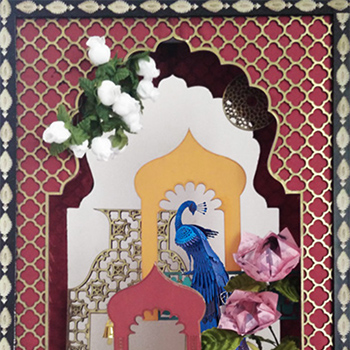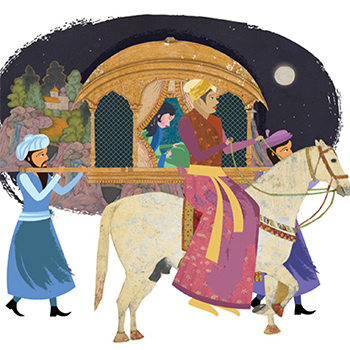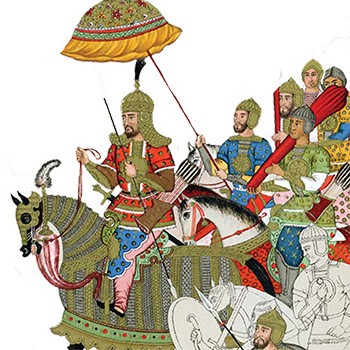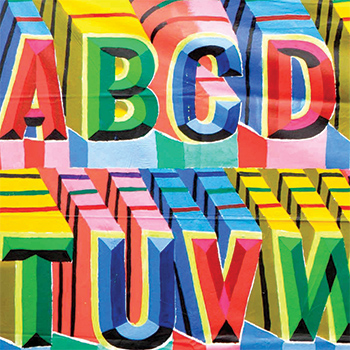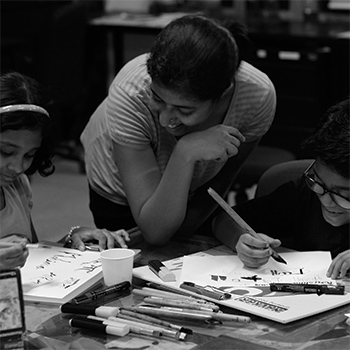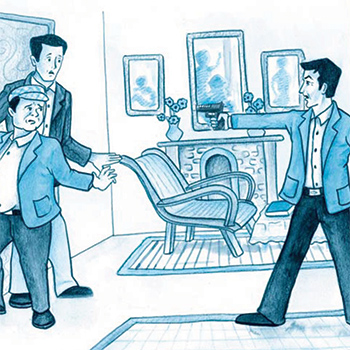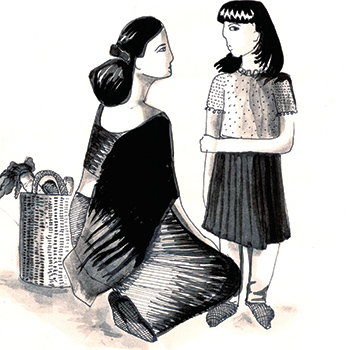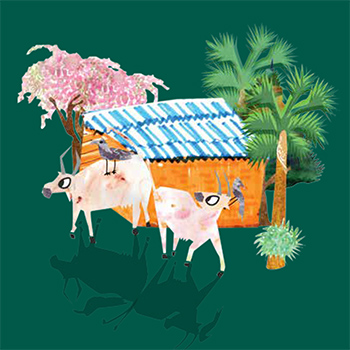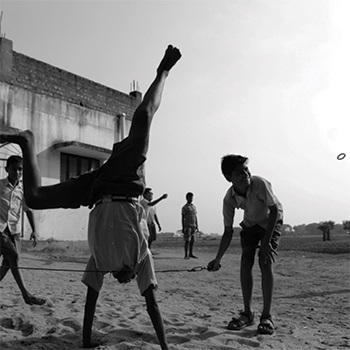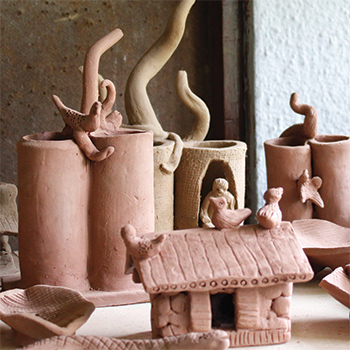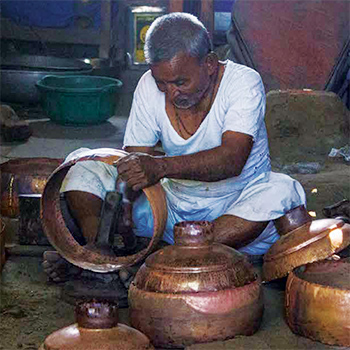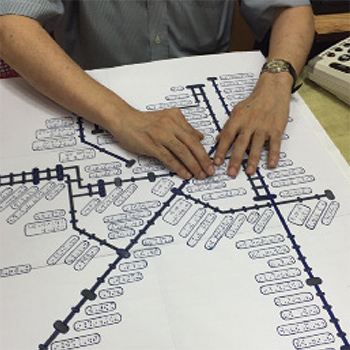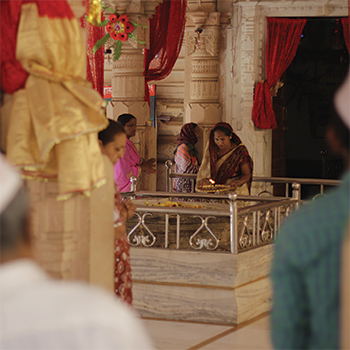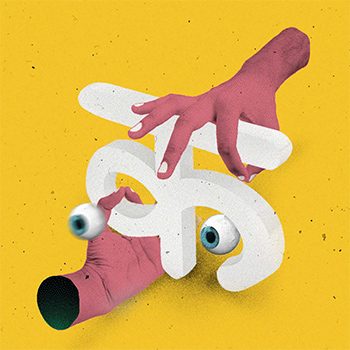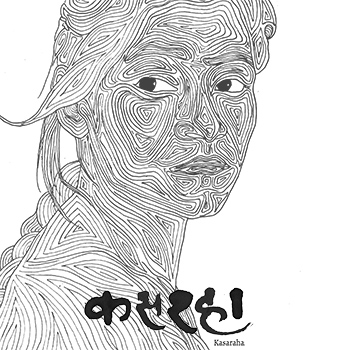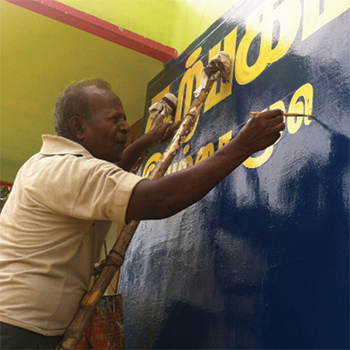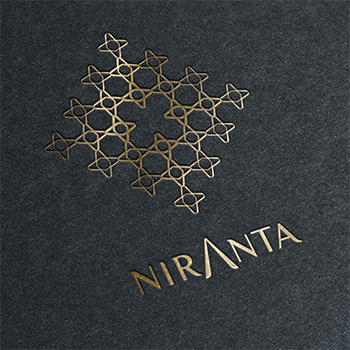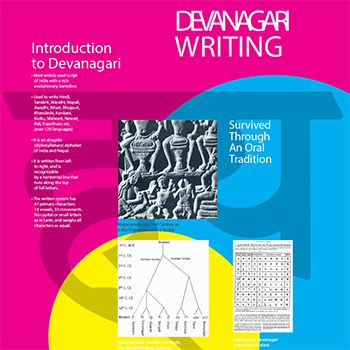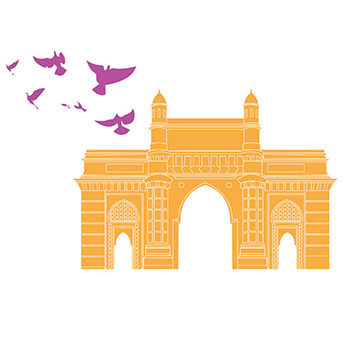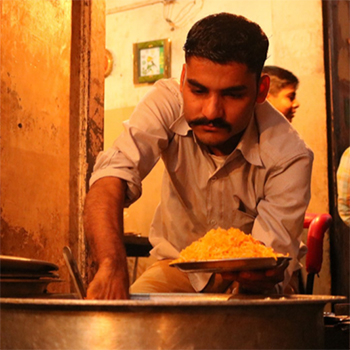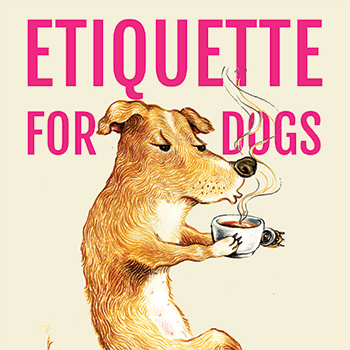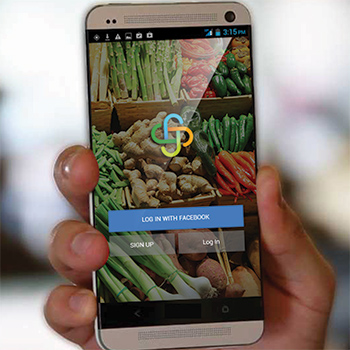Communication Design
Batch 2014-2016
(48 items)
Communication DesignBatch 2014-2016
(48 items)
(48 items)
Murtikar: Idol-makers of Pen
by Ameya Narvankar
by Ameya Narvankar
The elephant-headed god, Lord Ganesha,
is one of the most beloved and revered
amongst the Indian deities. Every year,
we celebrate the ten-day-long Ganesh
Chaturthi festival in his honour. In the
western states of India, particularly
Maharashtra, families welcome the god
by installing Ganesh murtis (idols) in their
homes and setting up pandals in public
places. Traditionally made with clay, and
now PoP (Plaster of Paris), they come in a
variety of shapes, sizes and designs. But
little do we know about the 'murtikars',
the people responsible for crafting these
beautiful idols.
My curiosity to learn more took me
to the small town of Pen in Maharashtra,
home to the traditional Ganesha idol
making industry. All year around, the
murtikars here work in their karkhanas and
mass produce the idols that are then sold
in metro cities.
During my visit to Pen, I was exposed
to the various processes of idol making
and got a peek into the life of the murtikar
for whom the traditional art form has
evolved into a year round occupation.
Details >>Visual Merchandising for benares
by Ameya Narvankar
by Ameya Narvankar
A celebration of all things beautiful, Good
Earth is India’s leading lifestyle and luxury
decor brand. As a part of my internship
programme, I had the delightful opportunity
to work with them on conceptualising and
visualising merchandising ideas for their
upcoming collection (2015-2016).
The following report describes my journey as
I undertook unique projects that challenged
& heightened my design sensibilities; and
contributed to my understanding of the
impact of visual communication on society.
I have presented my design outcomes in form
of tasks, each of which describe the objectives
of the project, my role and involvement in
the development, the challenges I faced along
the way, and how I overcame them to come up
with suitable solutions.
These tasks ranged from visual merchandising
to designing wall collages, all revolving
around the theme of Benares & its cultural
confluence for the 2015-2016 collection.
Details >>The visibility & representation of LGBT (Lesbian, Gay, Bisexual & Transgender) in Indian society
by Ameya Narvankar
by Ameya Narvankar
The Indian LGBT (Lesbian, Gay, Bisexual & Transgender) community
have for long struggled for their legal rights and acceptance, in a society
deeply entrenched in homophobia. With the reinstatement of sec 377 of
the Indian Penal Code that criminalises homosexual behaviour, it has led
to further discrimination of the community.
It is evident, that we, as a society are conditioned since childhood to
conform to certain gender roles and sexual identity. As we grow up, this
need to 'otherise' ideas we don't understand takes over and homophobia
raises its ugly head. It is the need of the hour to break this cycle and
educate our future generations on this much existent reality of our times.
The resources available to achieve this are minimal and for children,
quite rare. The mainstream has shied away from accurate representation
and often the depictions have been cruel and downright homophobic.
The project is an effort to add towards the positive representation of the
LGBT community through the medium of storytelling.
Ritu & Chandni's story (& struggle) in the form of an Illustrated
Storybook for Children - Ritu weds Chandi is the outcome of this
effort. Little Ayesha observes, questions and tries to make sense of the
resistance and stigma faced by her cousin's same-sex wedding, in this tale
on how love overcomes all odds.
The following report describes my journey as I broaden my
understanding of the LGBT community and subject; and arrive at a
design solution that allows me to contribute with the best of my abilities
as a visual communicator in a meaningful way to the same.
Details >>The story of MEHFUZ
by Ameya Narvankar
by Ameya Narvankar
History is a vast subject and is often dreaded by both students and adults
alike. The aim of this project is to generate a healthy curiosity towards
Indian History and make learning a richer and memorable experience.
The project began as an exercise in creating visual aids to facilitate
understanding for middle schoolchildren. However, after assessing the
subject I realised that my own understanding of history was inadequate
and thus began the process of re-learning. In addition to exploring
the various reading materials and media resources available on Mughal
History, I also undertook various activities which made my own learning
experience enjoyable and fun.
'The Mughal History Project' - story kit is the outcome of this effort.
The resulting story kit is a bundle of my own experiences that aims to
make history less intimidating for casual readers through the medium of
storytelling and activity.
It explores the A to Z of Mughal Social Life, right from the Atelier
to the Zenana; sharing nuggets of information on the larger-than-life
personalities of the Emperor and his wives, their grand and opulent
lifestyles, the court politics and not to forget the indelible mark they
left on Indian art & architecture, which is reflected in the Miniature
Painting style approach of the design.
The following report describes my approach towards re-learning and
understanding of Mughal History; and arriving at a design solution that
captures my own experiences and present it with the best of my abilities
as a visual communicator in a meaningful way to the same.
Details >>Visual Ethnography: Gadia Lohar
by Boski Jain
by Boski Jain
Gadia Lohars (also known as Gaduliya Lohars) are
a nomadic community of Rajasthan, India. They
are lohar (ironsmith) by profession who move from
place to place on bullock carts. These carts in Hindi
are called gadi, hence the name ‘Gadia Lohar’.
As they have been on a constant move since many
years, they are found in other parts of the country
too. They generally camp in the outskirts of city for
few weeks or months, temporarily establishing work
place and selling their in the markets of nearby city.
Their current economic status is not good and they
are in constant struggle for political rights since
they have been on a constant move from place to
place since many years.
This report is about one such group settled in the
outskirts of Bhopal, Madhya Pradesh. It is the
account of an attempt that has been made to study
the lifestyle of this ethnic group.
Details >>Gamification of Education
by Boski Jain
by Boski Jain
A project by IDC, IITB, and RSK (Rajya Shiksha Kendra) for government schools in Madhya Pradesh involves the creation of supplementary material that is game-based and interactive in order to enhance the quality of learning in primary schools across the state. (In classes 1–5, particularly in subjects like mathematics and languages English and Hindi), The workshop was conducted at IDC, IIT Bombay, and included students from the National Institute of Design, the National Institute of Fashion Technology, the Design Department at IIT Guwahati, and IDC, IIT Bombay.
Details >>Chadar Badar- A puppetry craft of Santals
by Boski Jain
by Boski Jain
The project is about understanding what
is happening to some traditions practiced
in rural areas of India in this an age where
‘development’ often assumes an aggressive
approach. This will be done through the
context of Chadar Badar- a puppetry craft of
the Santals. The project began with wanting
to understand reasons for its decline, its
relevance in the current times and the desire
to preserve or recover this practice.
Questions that arose after understanding
a field trip led to a closer scrutiny of
assumptions underlaying the urge to
‘preserve’ this tradition.
The project seeks to express dilemmas faced
both personally and collectively as our
societies attempt development. This will be
done in the form of a picture book.
Details >>Improving academic experience through better communication in the teacher-student community at IDC
by Boski Jain
by Boski Jain
Within the framework of the current education system, there is little conversation between teachers and students outside of the curriculum. Teachers and students do not take time or effort to discuss the importance of what is being taught or the methodology being used to do so. The project aims to understand the reasons for this. Talking more often and more freely about course content and projects can lead to better performance and fewer complaints on both sides. But it is apparent that this does not happen. To bridge this gap, solutions will be looked at that will help students speak freely about (a) each other’s work and (b) the course being taught, as well as help teachers analyse if what they want to convey is being understood by students or not. The project shall not suggest a new academic system but rather find opportunities within the current system that will cater to the stated problem.
Details >>Visual Grammar of Street Signage
by Kanika Kaul
by Kanika Kaul
This report documents hand painted street signage in some parts of New Delhi
and analyses the visual design decisions made by the artists.
As graphic design students, an understanding of visual communication
principles is critical for enhanced design choices. Observing the same choices
as made by untrained artists and the impact of their decisions give us a more
appreciative view of their craft.
Some examples of interesting signage and beautiful technique are presented in
this report, as well as insights from an interview with a practicing, established
signboard painter in Chawri Bazaar, an area of Old Delhi.
This project was undertaken at the Industrial Design Centre, IIT Bombay in
December 2015 and was guided by Prof. G V Sreekumar.
Details >>BIRA91: BUILDING A BRAND
by Kanika Kaul
by Kanika Kaul
Bira91 is a recently launched indigenous craft beer, currently retailing
in Delhi & Bengaluru. The parent company, Cerana Beverages,
approached DKMD in March 2015 with the brief of designing Bira’s
identity, right from its logo and surrounding brand language but
also its vision and strategic plans for the future to expand Bira’s loyal
fanbase and build a brand banking on goodwill and cheer.
The project covers contributions to Bira’s web & print presence as well
as concepts for image-building events that will strengthen Bira’s recall.
Details >>Teaching Devanagari Calligraphy To Children
by Kanika Kaul
by Kanika Kaul
This project documents a series of workshops conducted to teach children
between the ages of 10 & 12 Devanagari calligraphy with the intent to sensitize
them to the art of calligraphy and writing beautiful letterforms as well as
generate awareness about calligraphy not just as a hobby or craft activity but
also a creative process of expression.
I created a 3 workshop structure wherein I designed activities & tasks that
would aid their understanding of Devanagari and help them learn calligraphy
using a structured, step-by-step process. The activities begin with an
introduction to basic strokes and then move on to more complex and technical
aspects of calligraphy.
the children responded well to more traditional and basic tools and tasks
rather than abstracted versions of the same activities.
Details >>Design a self-sustaining, design-centric magazine, published by IDC
by Kanika Kaul
by Kanika Kaul
Magazines are a powerful tool to promote an ideology or way of thinking. However, in the current scenario, magazines are finding it difficult to sustain themselves without the support of advertisements as readership is dwindling due to the slow rise of the digital reading audience. I propose to create a design magazine, published by IDC and targeted at young, aspiring design students, that talks about not just design studios and important people in design in the country but also about larger aspects of design and displays a nuanced view of design as a field or study. A magazine is a perfect vehicle to propagate the design message, in that it not only provides information but is itself a canvas. Since there is no commercial motive behind this magazine, it will be able to disseminate a more holistic design ethos and thinking, which can be part of an evolving design pedagogy. I also aim to create a structure within which the magazine is able to sustain itself without having to restrict any aspect of its being in order to retain readership.
Details >>Word-Image Relationship
by Karan Vohra
by Karan Vohra
Images and text create a dynamic relation
which when unravelled creates several
questions. One might say that images
signify by virtue of resemblance or
imitation, words by contrast are arbitrary
signs, part of a language that signify by
virtue of custom or convention. Simply
saying that images are resemblance
may not be sufficient for sometimes
they resemble other images, illusions,
imaginations and creations. Be as that may,
an image also signifies something because
of a social agreement or convention, an
intersection with language, not just by
virtue of resemblance. The relationship
becomes more intertwined and playful
when storytelling becomes a factor.
The project is a way to gather a better
understanding of this relationship through
the lens of stories, especially those in the
curriculum of CBSE. A personal motivation
comes from the standpoint of being an
illustrator and storyteller myself. When
does an image supplement, contradict
or simply gets along with text. Are their
ways to objectively look at images and
their relation with words. Moreover the involvement of children allows for a fresher
perspective, garnering ways of seeing an
image when there exists familiarity with
the text. A simple match between text
and image may never be enough, far
from ideal, they may complement each
other, help push the message through
contradiction or encourage discovery. A
viewer’s relation with the two and the way
in which she participated (or doesn’t) affects
the relationship as well. These questions are
complex. Storytelling through the interplay
or word-image may demand fulfilment of
some factors as well. Discovering the same
is attempted.
Details >>Design Education Project, Khun Agastya Foundation
by Karan Vohra
by Karan Vohra
Agastya International Foundation is a Bangalore based non-profit educational trust that seeks to transform and stimulate the thinking of economically disadvantaged children. Agastya does this by bringing innovative science education to the doorsteps of government schools in various states in India. Ms. Latkar, Ms. Shah, and I went to the Agastya Foundation in Kuppam in order to understand the way this incredible foundation works as well as to conduct some workshops. Agastya brings students from schools in the vicinity and exposes them to technology, art, and multiple perspectives. I got the opportunity to carry out a shoe art workshop with nine girls from an all-girl residential school in Kuppam. Children were asked to make things that they loved, which in some ways defined them. Students used some incredible colour combinations and learned to use textures and patterns to aid their design. It was a fun-filled activity that gave me insights into organising workshops better.
Details >>Queer Voices
by Karan Vohra
by Karan Vohra
The word ‘Queer’ is an umbrella term for sexual and
gendered minorities. This community has borne the
brunt of intolerance and rejection from the Indian
society for a long time.
The project attempts to understand the nature of these
oppressions that they face, bringing out their voices to
lead to a better understanding of them. To translate the
‘them’ into ‘us’.
It does so by bringing in the perspectives, life
experiences and opinions of not only the queer
community but also of everyone on this sliding scale of
sexuality including heterosexuals.
Stories of these people existed before the retrogressive
act of 377 came into being, criminalizing homosexual
behavior in India. How has it affected these people?
What are the prejudices that they face (if any) and is
their a way to bridge this gap of our ignorance? These
are some of the questions the project attempts to
answer.
The project ‘Queer Voices’ drives its force from people
and their stories, complex multi-layered identities and
their tryst with sexuality.
Details >>Dahanu Tales: Facilitating english language learning
by Karan Vohra
by Karan Vohra
The project aims at facilitating English language
learning in resource constrained environments.
It aims at making the language more familiar in
a context where it is largely alien and enables an
engagement with it outside the ‘English classroom’.
One of the key ideas is to improve engagement
through content that reflects and is sensitive to the
socio-cultural and geographical landscape of the said
environment. This is done through games and stories
that reinforce vocabulary and alphabet recognition.
Details >>Graphic novel on start up at Powai
by Nilmani Kumar
by Nilmani Kumar
Powai is a suburban neighbourhood located in northeast Mumbai. Now a days known as ‘Powai valley’ because of startup which is making this particular area as a Mumbai’s most upmarket commercial and residential hub. This project is based on the journey of startup guys in the form of graphic novel. This graphic novel will try to express the thought of shaping the idea into reality as well as the emotional journey to becoming an entrepreneur.
Details >>Identity design for Infoedge India Ltd
by Nilmani Kumar
by Nilmani Kumar
The design brief was to redesign the logo for Info Edge India Limited. Infoedge is an online company, so they were keen to add some tech meaning to it. During the process, the brief changed from time to time. After the first presentation at Info Edge brief, identity can be derived from key words. After the second presentation, the brief was to come up with the initials of infoedge (I&E). The brief was to connect the pillars of the company with some tech meaning to it. Some memorable symbols It's easy to forget.
Details >>Story Book on Hearing Impaired
by Nilmani Kumar
by Nilmani Kumar
Deafness at birth or in early childhood has disastrous effects on the child’s overall development. In a country with millions of people, that amounts to a huge number. Language and communication unites as well as divides the diverse groups of people here. One such group is the hearing impaired(mute and deaf). This project traces an attempt to encourage and motivate hearing impaired people to chase their dreams, provide a glimpse of the world from the view point of hearing impaired people, provide examples of success stories of people who fought their disabilities and achieved their goals and encourage the society to accept and acknowledge people with disability.
Details >>Siksha kya hoti hai
by Nilmani Kumar
by Nilmani Kumar
History implies that the smallest of thought has led to the greatest transformation. But that noble act of change that generates from the simple thought of doing good must start from within ourselves first. And then to the society we live and grow, and ultimately to the whole world. Journey of this project starts from solving the educational problems being faced by the young minds in a place called Jharia, of the Jharkhand state. It focuses on the understanding of problem within the rural society of the state, and therefore it’s necessary to have an understanding of the subject that would lead us to a good solution. Education is a very broad term and hence this journey will give me an understanding towards the real meaning of education. Which will allow me to be able to define the framework for the good education.
Details >>Visual Communication Special Project
by Ravi Purty
by Ravi Purty
My journey began with lot of excitement in my heart, a chance to meet the people who are famous for their politeness and humbleness. I had lived the state of Uttar Pradesh for more than 18 years, and visited Lucknow on several occasions. This state is divided in 75 district, but there is nothing like Lucknow it has its own culture to appreciate people and it can be seen through generations. Lucknow is the second happiest city of India after Chandigarh according to a survey done LG electronics and IMRB International. Here life runs at its own pace. We may hear a lot of stories of Nawabs of Lucknow, but this city has remained beautiful because of its people. Pahle aap, pahle aap story may be famous because of Nawabs but one can still feel the same politeness from
Lucknow residents. People will have a lot of
time to talk to you, if they are not in real
hurry. There is so much to talk about this city
whether it art, drama, poetry, music, dance,
food, clothing and the people.
Chikan-Kari although introduced by Mughals
but Nawabs made it the legacy, and it still
continues. Some say it traveled from Persia
to India along with Nur Jahan, the begum of
Badshah Jahangir. Some references say it had
been here since 300 B.C. by Megasthenes,
who mentioned the work of white embroidery
on whote muslin. Whatever it was but it is
here today, an embroidery which remained
exclusive for this particular city has become
the identity of the Lucknow
Details >>Gamification of Education
by Ravi Purty
by Ravi Purty
This project gamification of education was organized by RSK (Rajya Shiksha Kendra), Govt of Madhya Pradesh and conducted by IDC, IIT Bombay. This project focuses on providing supplementary material for government schools of Madhya Pradesh. Prime objective of this project was to explore off-line as well as on-line/ digital medium and design/gamify the course content which is being taught in the schools. Studies suggest that reading, writing or arithmetic has not improved or gone down, at the same time rate of enrollment in private schools gone up as compared to government school in recent years. RSK realized the need of better study material which can improve the learning process and make it more engaging than mere textbooks. Idea of this project is project to make learning more engaging and light hearted so that they can meet other challenges which these schools are facing over several years. It needs to be addressed that there are abundant material already available in this domain, but not reaching to the children of these school.
Details >>Education for children of construction workers migrating to Mumbai
by Ravi Purty
by Ravi Purty
Every person in this world aspires to live a better life than he/she is current state. It had been a human tendency to look around for a better opportunity for their living and strive for it. Industrialization has opened the doors for people who lived at villages and can get a chance to move to urban settings. Industrialization had brought urbanization, as a number of people traveled from a different place and they needed a place to stay. Urban places got the chance to develop and various facilities like school, healthcare, administration, transportation were more accessible. Education (school education) as a tool helped many of the people to meet their dreams. They had been migrating since ages and everyone has evolved through it. On one side, there were people from privileged society who had
financial support to back them up, while on the other side there were people from underprivileged society. Talking of the privileged people, are the people those who get secondary level education or graduate level education which helps them to work in urban areas as Engineers, Doctors,Lawyers, Banks, Corporates, whereas there are people who don’t get proper education and forced to work as taxi-driver, domestic help,
housekeeping, construction workers etc. Civil societies have tried to help the second type of migrants in several ways. Providing education to the children of these people, so that they can get better opportunity to find a job and living This project is an attempt to understand how this civil society had tried to help the children of these migrants. Were these efforts helpful to, if yes then how and if not how it could be made better?Aman Day Care Centre was one of such opportunity to understand this scenario, and how it is different from the other institution for children of the people who didn’t migrate to the urban settings.
Details >>Information design on India's participation in Olympics
by Ravi Purty
by Ravi Purty
If you play, you will get spoiled, to become a king you
must study hard. Well, these were the lines which I used to
hear in my childhood. As like many of the children, I never
questioned why I should only focus on studies and not to
play. An aspiration which they were trying to build in me
was to become and engineer or an IAS officer since my
childhood. I always wanted to join the Air Force and yes,
my parents accepted this fact because I was not deviating
myself from studies.Performance in the academics was the only parameter at which we used to get evaluated, and many a times we were
compared with others as how well they are performing. If a
child is not getting good marks, he/she is sent for tuitions
and may be asked to an extra hour of study to improve. To
earn a good livelihood and lifestyle, it is assumed a person
must be good at studies else he/she may not have a great
career ahead. At the end it is all about money to be earned. If we discuss about today’s scenario, there is a lot of opportunity apart from traditional profession. A person can be good at various other skills apart from academics where he/she can build his/her career. The reason I am discussing about all this is because I used to love sports. At one point of time I had an opportunity to give it a try but did not know how to convince my parents. When you are good at something, and it gets appreciated, it motivates you to do more and better in that field. It is the story of thousands of people in the country. People are good at sports, but many a times they do not get support.One of the most important factors is the lack of awareness towards new and upcoming opportunities not only in the field of sports, but many other fields too. For the last 12-15 years, it has been noticed that Indian athletes have been performing in various events like Archery, Shooting, Wrestling, Boxing etc. and winning medals. It is important to appreciate and acknowledge their and efforts, and first
and foremost important things is to know about them.
Details >>Visual Ethnography of Beaten Brass Ghaagar
by Rucha Vakhariya
by Rucha Vakhariya
Beaten brass vessels especially Ghaagars and Handas are a very famous part of Barshi, a town in Maharashtra which also is my hometown. These vessels have been a part of childhood and growing up years. We use these to store water till date. This project gave me an opportunity to look into the making of these Ghaagars. I was lucky enough to be hosted by a wonderful family by the name of Gore who have been providing these vessels to my family shop for more than five decades now. I learnt about the entire process of making the Ghaagar. And also about a life very different than mine.Visual ethnography was a completely new field for me. With the excitement of a new subject and an age old tradition to explore I embarked on this journey of understanding the ‘Thokyachi Ghaagar’.
Details >>Coding and Font development of Ek Gujarati
by Rucha Vakhariya
by Rucha Vakhariya
The project undertaken at Ek Type was an attempt to realise the nuances of type design in regional scripts. The project I worked on was to code and develop the Ek Gujarati font. Ek Gujarati is a humanist monolinear typeface that is part of the Ek multiscript family. I worked on the regular and extrabold weights of Ek Gujarati. Gujarati script is quite similar to Devanagari script, minus the shirorekha. It has a distant feature that differentiates it from other Indian scripts, and that is the 'vanak'. With its differences came different challenges in coding. During the course of my internship, I learned how to use the software and programmes needed to code and develop an open-type font. The tools used during this project were FontLab Studio 5.1, Adobe Font Development Kit (afdko), and MakeOTF. MakeOTF requires one to have certain text files apart from a ttf font to develop an open-type font. There are certain specific commands that make these codes work. These included substitution rules, glyph positioning rules, defining glyphs, kerning, contextual substitution, et al. We followed a specific way of naming the glyphs, which helped us maintain consistency in coding. This will also make life easier for anyone who works on this font later. After a lot of trial and error, some serious and some silly, the font was successfully generated. The final part of this was to test the font to see if it worked. And it did.
Details >>Designing the Mumbai Rail Map for Blind
by Rucha Vakhariya
by Rucha Vakhariya
India, unlike other countries hasn’t addressed the issues of accessibility for people with disabilities quite well. Navigational systems that are built for people with vision usually work for people with hearing impairment and other disabilities. India has the largest blind population in the world. And these blind people face multiple issues in navigation. They depend highly on others for basic tasks like travelling to work everyday. Commuting to a new place is filled with a number of difficulties even for a person with vision. In a city like Mumbai where there are multiple modes of transport and the population so large, anxiety only builds up for a person trying to travel. For a person without vision this only multiplies. Mumbai’s rail network is extremely complex and one of the busiest in the world. There is no system in place that helps the blind understand this network and thus commute independently. And since the railways are one of the most prefered and important modes of transport in Mumbai, it becomes very important to understand it. This project is an attempt to aid the blind people in understanding this network better by using a map and making them independent while travelling on the trains.
Details >>To initiate a dialogue on the role and status of women in the Jain Community
by Rucha Vakhariya
by Rucha Vakhariya
Jains are statistically a very progressive community. They are highly educated, they have made their mark in almost every walk of life. They live comfortable lives and a have a high standard of living. Even the women in the community have a very high literacy rate. But despite all the prosperity, Jainism cannot boast of treating its women right. Jainism is a patriarchal religion like most other religions in the country, And through the years, women in Jainism have had a secondary status. Examples of this can be seen in the stories, scriptures and general hierarchy in the society. This has percolated in the society that we live in today. Not just the lay women, but also the nuns are given a secondary status in the community. Despite being educated, most women do not stand up against the prejudices and the injustice that happens in everyday life. This project is an attempt at questioning these everyday practices and starting a dialogue in the community
Details >>Unknown Bharat: Exploring the world of alternate healthcare in India
by Nitin Shekhar
by Nitin Shekhar
“For many millions of people, often living in rural areas of developing countries, herbal medicines, traditional treatments and traditional practitioners are the main – sometimes the only – source of healthcare. This is care that is close to homes, accessible and affordable.” Margaret Chan Director General World Health Organisation Chronic diseases and poverty work in a vicious cycle where they feed off each other. In such a situation providing quality medical care is more than a basic right. The physical well being of low income group and providing basic healthcare facilities becomes an important tool in fighting poverty in our country. One of biggest issues in developing nations like India is how they deal with Non Communicable Diseases. Diseases such as heart disease, stroke, cancer and chronic lung disease, kill more than 36 million people million people each year and account for 80% deaths in low- and mid-income countries. This is is furthered by the escalating cost of allopathic drugs which poses a huge challenge for our country. A large population of India still doesn’t have access to proper healthcare facilities. Traditional or local medical practices try to fill these gaps in our society. One can find them in tents or temporary setups across a lot of Indian cities. They have no professional degrees to follow their names. They boast of no palatial or air conditioned buildings as their clinics. Nor do they have any modern laboratories or sophisticated equipment to aid and assist them in the work of diagnosing their patients. All these constraints notwithstanding, these wayside doctors claim to cure almost all maladies of the human body. These medicine men work outside the purview of organizations controlling the medical system in India. They are considered outlaws in a rationalistic society which demands proof for everything. It’s a complex issue which sometimes runs head on with superstition. Through my brief study of roadside dawakhanas I tried to develop my understanding of the place of traditional methods in the current society.. For a majority of the population this is the care that is accessible and affordable..
Details >>The 5 Week Brand Strategist
by Nitin Shekhar
by Nitin Shekhar
Landor Associates is one of the world’s leading strategic brand consulting and design firms. Founded by Walter Landor in 1941, Landor pioneered many of the research, design, and consulting methods that are now standard in the branding industry. Partnering with clients, Landor drives business transformation and performance by creating brands that are more innovative, progressive, and dynamic than their competitors. Landor’s holistic approach to branding is a balance of rigorous, business-driven thinking and exceptional creativity. Its work spans the full breadth of branding services, including brand research and valuation, brand positioning and architecture, naming and writing, corporate identity and consumer packaging design, branded experience, brand equity management, brand engagement, and digital branding.Five years in India and Landor Mumbai is now a multidisciplinary, full-service consultancy
providing branding, design, and digital services. Some of our clients include Cafe Coffee Day, Delhi International Airport, ICICI Bank, Mahindra, Taj, Tata Global Beverages, The Park Hotels, Titan, and Usha Martin. The Landor 369 Studio specializes in fashion, food, and wine clients such as Anita Dongre, Busaba, and Charosa Wineries. Branding is a larger strategy of how the perception of consumers is changed and evolved over a long period of time. The design process while being important and being the face of the brand evolves out of the larger umbrella of brand strategy and brand positioning. These tried and tested strategies and methodologies have a fantastic potential to be used in taking design strategies and positioning to craftsmen and businesses who cannot generally afford design agencies.
Details >>Revival of Devanagari font from Hindi film title
by Nitin Shekhar
by Nitin Shekhar
Films have been using typefaces the same way they have been using music, sound, colours, editing, and lighting to complement and construct the narrative as a whole. They evoke a certain feeling, they subtly suggest what is about to unfold and at times they put you in a mood to laugh, cry or be gripped with fear of something. Typefaces in films along with the other elements are invested with the responsibility of expressing and taking the narrative forward and hence the fonts used in films are an excellent place to delve in to while looking for expressive typefaces. Lettering used in films was specific to the films they were meant for and that way it was unique. Our goal in this project was to put to use the uniqueness and use this inspiration as a base for the project. We have focused primarily on the pre-digital era movie titles which were crafted by hand. Pre-digital era movie titles carry the aesthetics of a bygone era and represent the then prevalent culture. The lettering used in movies were never intended to be carried on to any large scale reproduction and printing. Painters/designers of movie titles could dip into their long years of training in traditional hand lettering and the craft has evolved and refined seamlessly through the ages. That in itself makes film titles an invaluable source for type design. It is difficult to reproduce the same style consistently if we are forced to recreating fonts manually. Our attempt was to transition the hand lettering in the titles by extracting their values and re interpreting them to make a font that contextualizes it for the current times.
Details >>Film on the Role of Rationality & Beliefs
by Nitin Shekhar
by Nitin Shekhar
India today is plagued by superstitious and irrational religious practices. Only three states in India have laws specifically targeting these practices. Over the past four decades there are many rationalists organisations in India which have successfully targeted internationally popular “god men” who boast a following of millions, exposing their activities as nothing but “well-packaged gimmickry”. In a bid to debunk belief in miracles, palmistry and astrology in the countryside, where the majority of people are illiterate and believe in the supernatural, there are several organisations which hold regular workshops and street plays. These organisations have been trying to pass laws which prohibit godmen from perpetuating these superstitions which hasn’t found a lot of takers. Yet we see religiosity declining in some factions of the society which makes us ask the question about the importance of beliefs and religiosity in today’s day and age. As much as they are considered foolish, superstitions do affect the society a lot. A large section of our society believes in superstition and blindly follow religious practices and therefore fall prey to conmen and godmen and it hinders social progress. Superstitions should not be confused with tradition and culture. Through this project we aim to look at how various groups in the society look at religions and what their belief systems are. Fiction and films influence public opinion, not by making political statements or attacking certain sections, but by the stories they tell and the way they tell them. I would like to stay away from the documentary format and focus towards a fictional film that addresses or asks these questions instead of a film that takes a stand disseminates information. The larger question of what beliefs are and why they are followed needs to be answered. Through this project I want to address the issues behind religion, belief, religiosity, tradition, culture and rationalism through a film
Details >>Visual Grammar of Hand-painted Signs in Tamil Nadu
by Shreshta Jaisingh
by Shreshta Jaisingh
Amongst the various directional and shop signage, political graphics can be seen all over Tamil Nadu. Every election seems to paint the towns and cities afresh. Today however, there is a growing number of flex banners and printed paraphernalia. Rapidly advancing digitalization of visual space in India is replacing individual creative efforts. On the surface, due to the lack of a clear visual language, the sheer multitude of these signs create visual chaos more than they do order. Tamil characters are larger, rounder and wider than Latin letters, fitting the two together often compromises on legibility. However, on a functional level, do these signs still work? What do they add to the visual of their surroundings? Painting these signs is usually someone’s livelihood. Usually these hand skills are passed on from one generation to the other, along with their fresh and unique appeal and quirks. They are easily identifiable and are an important detail in the visual “brand” of any city—instantly recognizable anywhere. In the course of this project, I was fortunate enough to come across a sign painter and observe his skill. I was also able to identify certain styles or unique characteristics of the signages in and around my hometown, which I easily overlooked before, due to the chaos and visual clutter. This project proved to be a chance to document the sensitivity and fineness of indigenous typography. The locally originating character of marketplaces, hospitals, bus stands, etc.; from where these signs were collected brings forth the native nature of these hand-painted typographical expressions.
Details >>Branding Transit Hotel at Mial Packaging Vanish Stain Remover
by Shreshta Jaisingh
by Shreshta Jaisingh
Tata Elxsi commenced its business on May 5th, 1989, headquartered in Bangalore, India, with a global network of offices in Dubai, France, Germany, Japan, Malaysia, Singapore, South Africa, UAE, UK, and USA, to develop and promote applications of electronics, embedded systems, and software. The service they provided in the areas of Service Design, Design Research, UI/UX, Product, Visual, and Automotive Design was exceptional. The Graphics team started as an auxiliary to the Product Design department, mostly to create standard packaging labels. Over 3,000 employees are working in the Design Factory. "(Brands are) a fascist state where we all salute the logo and have little opportunity for criticism because our newspapers, television stations, internet servers, streets, and retail spaces are all controlled by multinational corporate interests." Brands began not as a means for consumer exploitation but for consumer protection. In pre-industrial days, a brand provided a guarantee of reliability and quality. Its owner had a powerful incentive to ensure good products in order to persuade people to come back for more. Distance created a need for brands. In poor countries, the arrival of foreign brands points to an increase in competition.
Details >>The History of Devanagari Typography
by Shreshta Jaisingh
by Shreshta Jaisingh
The first stage of this project involved collection of data from various academic sources—papers, journals, blogs; my study relies on Bapurao Naik’s “Typography of Devanagari”—the book is comprehensive until a certain point in Devanagari’s time-line. After that, the guidance and works of Professor G V Sreekumar and Dr. Girish Dalvi, combined with references to reports by previous students at IDC that attempted to study various aspects of type-design brought to light newer perspectives and data. This data has been analyzed and sifted through, in order to create a perspective that is accurate and free from bias. Content was created with focus on the message, regardless of medium. A time-line was created for the script right from its evolution from Brahmi until the creation of modern day type foundries such as Ek Type and Indian Type Foundry. The History of Devanagari has been traced through inscriptions, first attempts at hot metal printing in India and overseas during the colonial era, until current day where it is designed on a computer. Filling the gaps in the information to create a concise output has been the greatest challenge of this project. In order to preserve the nuances of the script and not lose it to the constraints of technology, value has to be added to it by those who design. There is a dire need for designers in the field of script typeface design in this age of digitization and responsive web design. My project aims to inspire and provide a comprehensive reference point for such designers. The report concludes with a set of typographic panels, that can be displayed at academic institutes or design gatherings attended by students and professionals alike
Details >>Design to Encourage Walking and Cycling
by Shreshta Jaisingh
by Shreshta Jaisingh
Cycling and walking are two of the most
prime methods of transport. Such modes
of ‘Active Transport’ give us the most control
over our movement. These are two activities
that one can never forget, as it is so ingrained
in our muscle memory. Why then, in a society
that is increasingly health conscious, where
medicine has made leaps and bounds to
extend longevity, where fitness is not just a
trend but a way of life, do we still not adopt
these methods of basic human movement into
our daily lives?
The pollution from our vehicles causes our
temperatures to rise, motorized transport
strains all our resources and creates a looming
mess that we can’t seem to clean up. We
are a society bombarded with choices and
advertorial messages all day, everyday; we have
a world of knowledge at our fingertips, yet
there is a requirement for an external stimuli
that can make us reconsider our choices that
we make in our daily lives.
This project falls into a realm of work that
provides this stimuli. An initial survey involved
asking people their preferences and why they simply do not make a conscientious effort
to contribute to the well-being of the planet
though the means involves merely taking
care of their own bodies. Understanding the
problem, though it might seem like reinventing
the wheel, is part of the process in order to
understand and gain insights about this innate
laziness that we as a generation seem to have
so easily adapted to.
Work done that is similar to this endeavor
in other such situations around the world
was studied as part of secondary research,
wherever similar efforts to promote walking
or cycling were taken.
Much work has been done in glamorizing
cycling as a sport and not enough promoting
it as a means of transport. The most active
cities in the world all have one obvious
common quality of possessing the basic
infrastructure needed to pursue such means
of transport. Since that aspect is not under
my control in the realm of a design project,
I decided to dedicate my project to those
who are already inclined to physical activity. My outcome is a piece of communication
that recognizes the limitations of influencing
opinion and serves as an aide to people who
want to pursure exploring the city in an
unusual manner. It is for those who want
to see it through a more personal perspective
and need an incentive to plan out their own
adventures. This project is created for the love
of being outdoors, be it in an urban landscape
or to be a little closer to the strains of nature
around us. It is an aide towards making
a more conscientious and healthy choice.
Details >>Visual ethnography
by Shayam V.S.
by Shayam V.S.
While doing my undergraduate studies in Fashion, I was fascinated to learn about fashion subcultures ( e.g.: Goth, punk) and how they evolve. I began to wonder if India had any such street style subcultures and what are the factors which influence those. In India, there is an urban crowd with social media accounts, who is aware of global trends who makes very similar styling choices , there is another crowd influenced by bollywood and there is another set of people who are least aware of fashion or trends. This group of people, most of whom are rural sometimes come up with the most unique ways of dressing and have a very personal style. I have always been fascinated with the way women from North-east parts of India dress. Northeastersn traditional attires are quite elegant and unique. The women seems to have an effortless sense of style. So as a part of DRS, I would like to understand the factors which influence the way the women of Manipur chose clothing. Further, I would like to study how they balance traditional influences, global and local influences to alter the way they dress
Details >>Summer Internship Project
by Shayam V.S.
by Shayam V.S.
This written submission of my summer internship includes an account of the different types of work I have done during the time I interned at Tantadan Design, Thane. I interned for a period of four weeks from the 1st of June, 2015 till the 30th. As a fresher to the graphic design industry, my primary aim was to understand the workflow, design process followed and to gain a first hand experience of the dynamics of working in a creative studio environment. I also wanted to strengthen my technical skills and gain an understanding of my strengths and weaknesses.
Details >>From farm to plate
by Shayam V.S.
by Shayam V.S.
This project aims to understand food in the context of a country with a huge population & economic disparity and to learn about food and safe food in terms of what is being done & what could be done, what attitudes prevail. The world is anticipating a food security challenge due to the rise in global population and hence there are debates on whether industrial food system can meet the challenges while being ethically right and environmentally sustainable. Rethinking of how we approach everyday food behaviours that are more environmentally aware, socially inclusive, and healthier appears to be a particularly timely concern. The project aims to study ideas, behaviours, knowledge, practices and attitudes towards food within through a process of extended conversations with diverse people and to communicate them through an illustrated book.
Details >>Design for History Learning: Engaging & Contexualised History Education
by Shayam V.S.
by Shayam V.S.
The National Curriculum Framework 2005 envisions an education, where children are given a space to reflect, ask questions, wonder, and probe sources of knowledge outside the textbook. A lot of people in India have been working towards making this dream a reality. But even now history still remains a student’s nightmare in schools. The vastness of the subject adds to the drab of trying to learn it. But most of the time, it is also hard to relate to the lives of some King or Queen, living somewhere with life and culture too different from what a child knows. As of now, the school syllabus is largely centralised and hence cannot include local perceptions to a large extend. By enabling communities to include their local history and culture to be a part of education, we empower them and help us connect better to the nation. In this project I have attempted to aid this process of transforming history learning into a more palpable experience by creating resources to document and exhibit a student’s enquiry into his or her own history and share it with the world. This project’s initial goal was to create a set of learning and teaching material, specific to a locality to help students’ of that locality make sense of their identity in relation to individual and to the world. The locality I have focussed on is Kozhikode which used to be a part of Malabar. So I have learned about the history of Kerala, Malabar to build a knowledge base. My outcome is a crowdsourced web platform which can nudge the schools in Calicut to participate in contributing to the history of Kozhikode.
Details >>Daslarkhwan
by Suruchi Sati
by Suruchi Sati
Lucknow, the capital city of Uttar Pradesh, is one of the most vibrant cities in India, and is among the top ten fastest growing non-major-metropolitan cities of India. Today’s Lucknow has a varied character, that boasts extravagant, pedantic recent architectural additions that lack ethos, a mixed cultural scenario, thriving commercial opportunities and a highly sought after active political arena. However, less than a hundred years back, it was primarily known as the leisure city, the cultural capital of the Awadh that thrived under the reign of the Nawabs, who left a cultural legacy of appreciation for food, music, dance and beauty. as well as a series of delicate, beautiful spaces and experiences that are faintly reminiscent of the rich Nawabi culture. Despite a rich former identity it held strongly in it’s historical background, the city has evolved through rapid globalisation and fast paced ways of new era. However, some of it’s past has managed to find a place in the lives of the contemporary population. Local food habits and demands in particular, seem to have been very accepting of the new additions while also being inclusive of the older ways, which is quite delightful an experience for the foodies who often wander into the city to try out the local delicacies. Had it not been for the immaculately ancient ways of the local natives, their longing for the past, and the brilliant old token heritage buildings, museums and music and dance schools, the cultural of the Nawab’s would have been almost mythical by now. Having had my own personal encounters with the Awadhi food culture, I took on this project out of sheer fascination, to understand the nuances of a culture which is till date celebrated for it’s delicate character. Visual ethnography, the chosen method of research proved to be a suitable tool during field work. The aim was to understand and effectively capture changes that were brought about in Awadhi culture and food over the years and what promise it holds for the future.
Details >>Gamification of Education
by Suruchi Sati
by Suruchi Sati
Indian education system has been lacking many appropriate and necessary resources and therefore, has failed to be effective, for a very long time. It has often been criticized for being too rigid and based on rote learning rather than problem solving. There is also an acute shortage of qualified Indians in Indian education system. Apart from the obvious issues, there are also many deeply embedded problems that need to be studied and worked upon, in order to improve the quality of education. ‘KHEL’ is an ambitious project aimed at improving the quality of education in the schools of Madhya Pradesh, and hence make a contribution to the betterment of the Indian education scenario, by generating supplementary material based on game-plays and activities. The opportunity to be a part of this project offered to encompassed many of aspects of quality education and learning based on thorough research and interactions, and resultantly provide us, participants, with an opportunity to contribute to the possibility of a better future for the underprivileged kids in Madhya Pradesh
Details >>A Divided World
by Suruchi Sati
by Suruchi Sati
In Mumbai, there are around two million stray. IIT Bombay, due to its proximity to Sanjay Gandhi National Park and Powai Lake, itself houses many different kinds and species of stray and wild animals, which includes, stray dogs, cats, monkeys, snakes, leopards, etc. One of the major issues, as reported by the residents, is the presence of stray dogs and cats. For many years, the human residents of IITB have had a variety of responses on the situation. The community here is mostly divided on the issue, and, hence there is a dire need for a formal / informal, functional body or committee, with a vision based on compassions without bias, that could cater to the needs of the residents of the campus, both humans and animals. Through this project, I hope to understand the practical and ideological reasons responsible for the stray dog-human conflict at IITB and propose solutions that keep the relevant welfare of both people and stray dogs residing in the campus
Details >>Understanding the Elderly
by Suruchi Sati
by Suruchi Sati
Through this project, I have made an effort to understand the realm of old age and how it speaks to the younger generation. The project eventually culminates making a film which speaks of the struggles faced by the abandoned elderly and the caretakers in old age homes. The film aims at encouraging the younger generation to open their hearts to the struggles of the elderly, and take notice of the innocence that comes with old age, a quality which could eventually be a source of joy to many such people young people, who themselves are struggling through today’s fast paced ways of life with a hardened heart. At the core of this project, I have tried to re access the evolution of my relationship with my grandparents, take a closer look at similar experiences of my peers and the elderly themselves, and articulate the learnings either through personal or a third person’s point of view that could speak to one’s sensibilities
Details >>The Ceramic City Khurja
by Tapan Kumar
by Tapan Kumar
The pottery industry of Khurja makes a variety of ceramic goods such as flower vases, object d’art, crockery, industrial ceramics like chemical porcelain, ball mill linings and balls, electrical and electronic ceramics like low tension (L.I.) and high tension (H.T.) insulators, spark plugs, sanitary ware, stoneware jars, etc. Crockery and insulators account for the major share of what is produced in Khurja. Ceramic insulators and laboratory equipments are made directly by the big factories on special orders. And their production is totally dedicated to outside vendors and industries. But rest of the items can be found very easily in the local markets and Highway side emporiums. Fancy emporium is a famous emporium at Munda Kheda Chowk. There were several varieties of crockeries, vases, Chandeliers, ash trays etc
Details >>Designing mobile application for the flying grocers
by Tapan Kumar
by Tapan Kumar
The first project handed over to me was Logo Design for a New Delhi based Start up by the name of The Flying Grocers. The Flying Grocers is a new online and offline grocery store which is entering into the business of online Grocery Store. It will have both online and offline grocery stores. One can order either online or can physically go to the nearby store to purchase grocery. Client gave a very clear brief that there company will claim to deliver fastest and at reasonable rates. Colours that will be used in should be cool colours and should go with the functionality of the company. The most important brief was that the company is going to start its new E-commerce business, the logo should look good and eye catchy on the screen. I started primary sketches on paper and after multiple iteration I finally reached the logo that client actually approved
Details >>Participatory Design with Bhil Artists
by Tapan Kumar
by Tapan Kumar
Bhils being the third largest tribe of South Asia, have a population of over 25 million in India. Their art and culture has a big part in Indian tradition and folk art. Bhils have a lot of untapped and untold interesting stories and narratives that should be explored and put forward in front of large audiences. People nowadays are more inclined towards western culture, films, art and theatre etc. Although its a personal choice, we should also be sensitive towards our own art and cultural heritage. This project is to bring awareness among today’s fast moving tech savvy generation and give a totally new perspective towards Bhil art. Through the support of Tata Centre for Technology and Design, Prof. Nina Sabnani, IDC IIT Bombay took this great initiative and started the project ‘Telling it Together’. This project is concerned with the themes of craft development, education and technology. It brings together designers and craft communities to create media artifacts that enhance the reach through digital media and offer new opportunities for craft development and craft awareness. The objective is to engage and collaborate with the Bhil community of Madhya Pradesh that has its own unique form of painting and narratives that can be transformed into different artifacts, animated films and illustrated books
Details >>Participatory Design with Bhil Artists (Game Development Phase)
by Tapan Kumar
by Tapan Kumar
This project will be the next stage of my Academic Project 2 Participatory Design with Bhil Artists. In the previous phase (Project 2) the main focus was understanding the Bhils, their cultural values and their narrative paintings. The main goal of the project was to create a visibility for their art through game design. Thus the main focus was on understanding the community and then taking some aspects of their culture to conceptualize the game Bhagoria. The final output at this stage was the game play, graphic representations etc. Now, moving on to the next level of this project which is Project 3. I am taking the same game project Bhagoria to its implementation stage. In this stage, the focus would be on rectifying the feedbacks from previous stage, designing the game props, animations, sound effects, main and mid cutaway story animations, finalizing the game mechanics, coding of the game and finally packaging the whole game design into a working game application. And if possible I would like to test the game as well. This phase of the project would help me to understand and learn the game development process, which includes animation, sound effects and game mechanics: basically from the idea and concept stage to the final execution of the deliverable. The most important learning would be to understand how any digital design is likely to change and grow in its journey from concept to its final execution stage
Details >>
